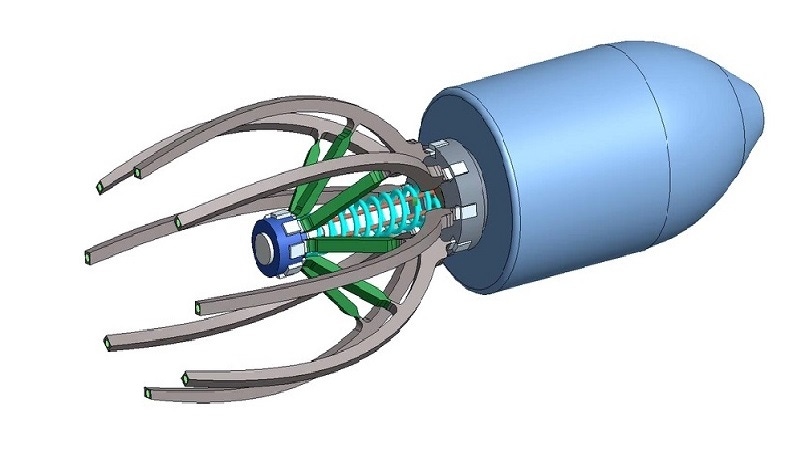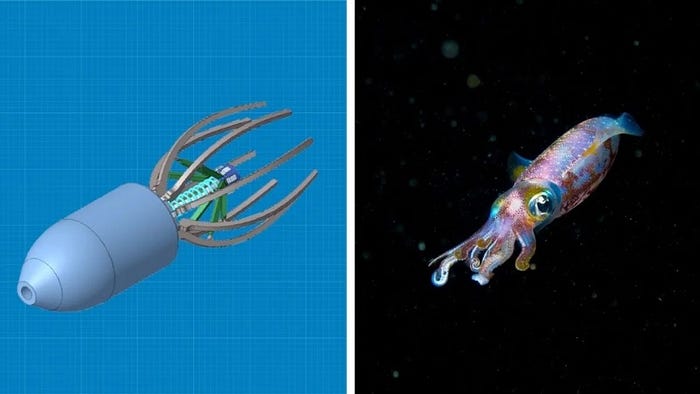Squid-Robot Learned Its Moves from Marine Animals
This underwater robot propels itself through water in the same propulsive technique as squids and nature's most efficient swimmer – the Aurelia aurita jellyfish.
January 23, 2024

At a Glance
- Underwater robots
- Nature-inspired movement
Here’s a new turn on the ongoing effort to turn the mechanics of the natural world into robot movement. Scientists at the University of Southampton and University of Edinburgh have developed a flexible underwater robot that can propel itself through water in the same style as squids and the Aurelia aurita jellyfish.
The findings demonstrate that the new underwater robot can swim as quickly and efficiently as the squid and jellyfish. The development unlocks possibilities for underwater exploration with the robot’s lightweight design and soft exterior.
Co-author of the report on the underwater robot, Francesco Giorgio-Serchi, lecturer at the School of Engineering, University of Edinburgh, noted that "The fascination for organisms such as squid, jellyfish and octopuses has been growing enormously because they are quite unique in that their lack of supportive skeletal structure does not prevent them from outstanding feats of swimming." Scientists view the jellyfish as a demonstration of the most efficient animal movement in nature. Ty jellyfish easily beat running and flying animals as well as bony fish.
Resonance for Underwater Propulsion
The robot was developed at the University of Southampton and is the first submersible to demonstrate the benefits of using resonance for underwater propulsion. Resonance refers to large vibrations that occur when applying a force at the ideal frequency, like pushing a child on a swing. This allows the robot to use very little power but generate large water jets to push itself forward.
In the robot, the simple but effective mechanism consists of a rubber membrane enclosing eight 3D-printed flexible ribs, which together form a propulsive bell. A small piston in the top half of the robot taps this bell repeatedly so that it expands and then springs back. This mimics a jellyfish's swimming technique and produces jets of fluid to propel the robot through the water. When the piston operates at the correct frequency, the robot can move at one body length per second and match the efficiency of the Aurella aurita jellyfish.
The scientists notes that tests show the new robot is ten to fifty times more efficient than typical small underwater vehicles powered by propellers. They explained that increased efficiency, combined with the additional benefits of the robot's soft flexible exterior make it ideal for operating near sensitive environments such as a coral reef, archaeological sites, or waters crowded with swimmers.

University of Southampton
Co-author Thierry Bujard, a masters student in Naval Architecture at the University of Southampton, designed and built the robot in a matter of months. Bujard noted that "Previous attempts to propel underwater robots with jetting systems have involved pushing water through a rigid tube but we wanted to take it further so we brought in elasticity and resonance to mimic biology. I was really surprised by the results, I was confident that the design would work but the efficiency of the robot was much greater than I expected."
Gabriel Weymouth, associate professor in the university's School of Engineering, who supervised the project added, "The great thing about using resonance is that we can achieve large vibrations of the propulsive bell with a very small amount of power. We just need to poke it out of shape and let the elasticity and inertia do the rest.”
In recent years we have seen considerable research into flexible and biologically-inspired robots, such as Boston Dynamic's Big Dog. These nature-inspired robots tend to be much more versatile than standard industry robots. This research joins a number projects in the last few years that mimic the moment of marine animals to create underwater robotics.
"There are still many challenges and exciting possibilities to explore with soft underwater robotic technologies. We are now looking to extend the concept behind this robot to a fully manoeuvrable and autonomous underwater vehicle capable of sensing and navigating its environment,” said Weymouth.
About the Author(s)
You May Also Like





